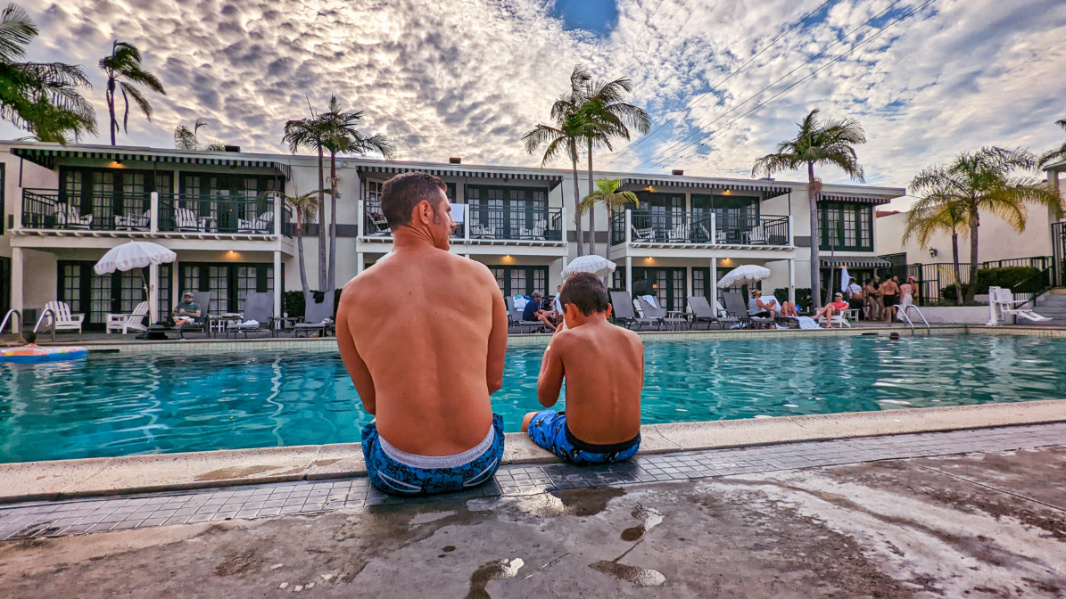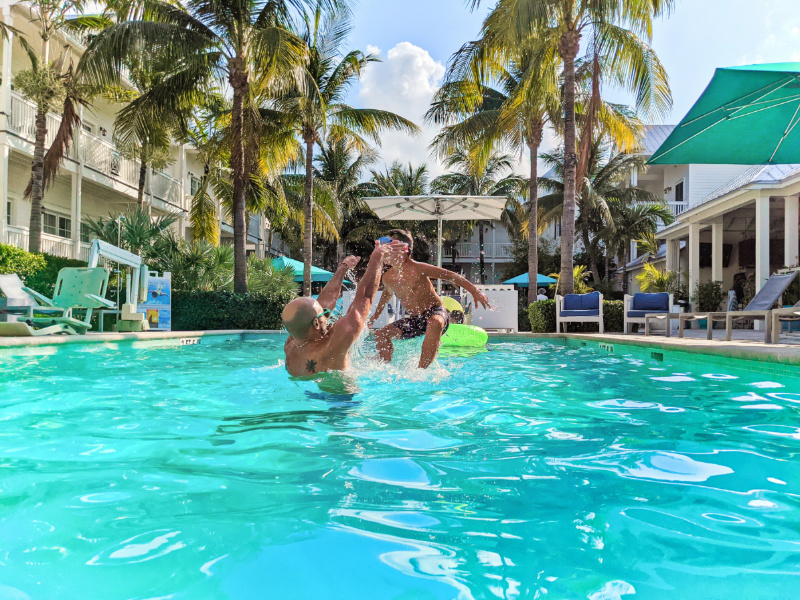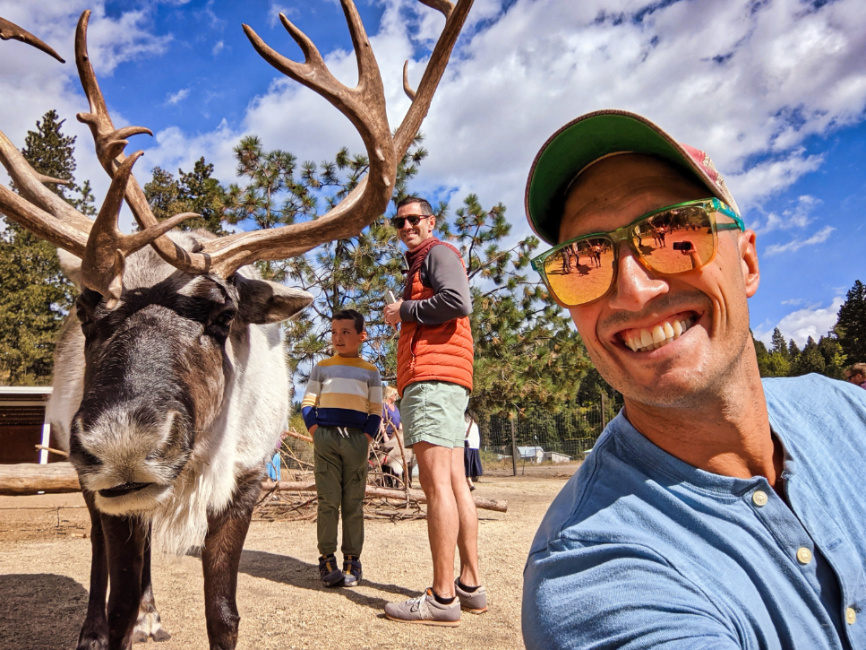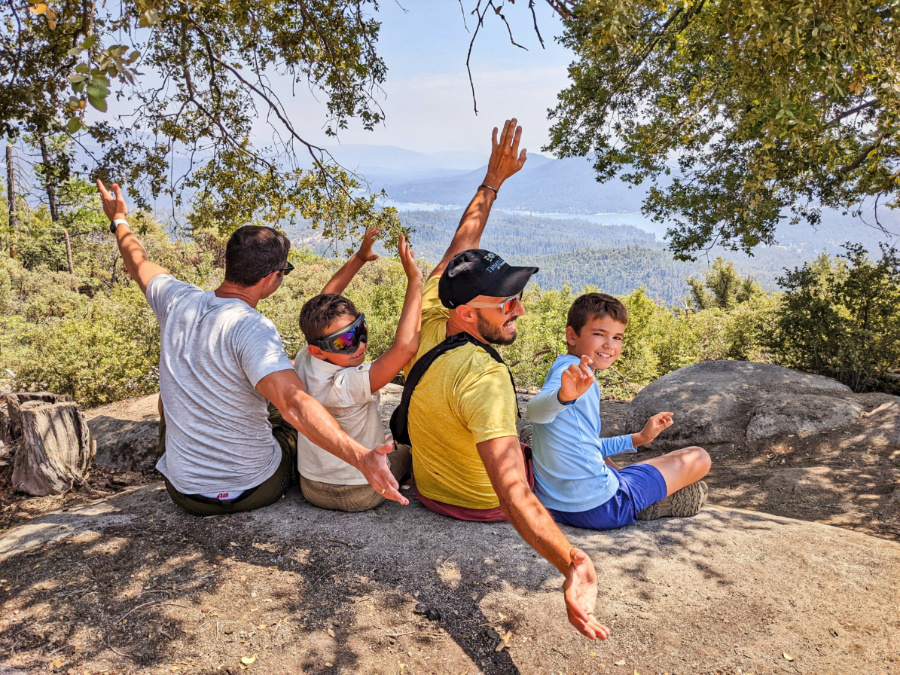Hey there! You’re here if you are looking for a bit more information or guidance around successful pitching or creating brand relationships. The information you’ll find here is the baseline for how we operate our blog and manage our client relationships. Please remember that every blog, every writer, and every brand is different, so be flexible and you’ll find your perfect pitch method!
We do both paid partnerships and hosted visits. We have our own guidelines for when we’ll do each sort of partnership, including our own business goals, content plan and how much time we’re away from home. We balance running our blogs with being parents, landlords and one of us having a corporate job, so what we evaluate and grant value to may be very different from where you see value.
Who am I to Talk About This?
Hi there! I’m Rob Taylor, the founder of 2TravelDads, Paddle Your State, St Augustine Explored and more! I’ve worked in travel and tourism since 2000 having jobs ranging from housekeeping to room service, concierge to hotel management. I’ve been running 2TravelDads as both a place to share our family’s stories and as a successful business since 2014.
In addition to the work I do on our blogs, I’ve also written two books (Road Trip Survival Guide and Ultimate Travel Journal for Kids), host a podcast, have had television and radio spots, and do consulting work within the travel industry. If I’m sharing something with you, either about travel or professional matters, know that I have receipts. 🙂

Need to Knows for Pitching Tourism Partnerships
Going into a pitch, it’s good to be knowledgeable and professional. There are some important pieces of verbiage that will make a conversation go smoothly and swiftly.
A few notes and terms to know before pitching…
WHO You’re Pitching To
- DMO – Destination Marketing Organization, this is a group responsible for promoting a town, city, region, state, province, country… MARKETING for the tourism entity which may be either government funded or membership based (Chamber of Commerce)
- PR – Public Relations, many companies have their own PR or Sales and Marketing teams, or they may contract it out to a vendor. Contact with PR is important because it’s a very fluid field with individuals frequently changing clients or companies. Public Relations relates to press / earned media coverage
- Agency – this is a third party who’s been hired by a destination, company or brand to manage all sorts of coverage, from paid campaigns to earned media
- Host – the party who is welcoming you to their destination, lodging, dining establishment or activity. This party is providing you the experience for the purpose of content creation. If something is HOSTED, there should be no cost to you (except gratuities, which should be clarified in advance)
Types of Content Plans to Pitch (or be offered)
- Earned Media – media / published stories and content resulting from a media visit or “press trip”. This is unpaid work (working fees not paid) and any / all content creation and publishing is 100% to your discretion. No requirements of content should be set by the partner. If they are requiring predetermined work, they should be paying for your time, skills and resources.
- Campaign – this is a paid partnership with a set of deliverables or marketing goal. If a partner says there are minimum deliverables, you are participating in a campaign and doing work determined by somebody else. This should ALWAYS be paid. You are working towards somebody else’s goal or project end and should be compensated as a worker.
- Fam Trip – a familiarization trip is when an individual or group is invited or it’s been arranged to explore a destination or set of site/activities. Press trips, hosted stays and complimentary tours may be considered fam trips. These may result in Earned Media output.
General Tourism Terms to Know
- Deliverables – these are the requirements of a partner in terms of content output. If you are presented with required deliverables as a part of a visit of some sort, that is a Campaign function and is paid work. If you are not being paid by your tourism partner for the work you do, the work is 100% to your discretion and in no way is due back to the partner on a timeline or for their own use.
- Usage Rights – participating in a travel experience may generate a variety of content including, but now limited to, images, video clips, written content, social media imagery and copy. These products belong to YOU and are not owed to your tourism partner unless you’ve agreed to furnish them with paid usage rights via a contract.
- Assets – the content you create and provide for another’s business use is an asset. This includes the products noted in Usage Rights (above). Assets come with term limitations and are protected by copyright laws.
- FTC Disclosure – FTC disclosures should be used in content creation relating to fam trips, campaigns and hosted experiences. To remain within the law and to not be penalized financially or in Google ranking, it’s important to disclose to your reader or follower that you are in partnership with a destination, brand or company.
- Hospitality – resorts, hotels, lodges and other forms of accommodations all fall within the term “hospitality”. While all have a small overhead when it comes to the cost of hosting, not every hospitality entity has the budget for it (more below).
- Shoulder Season – this is the time between busy and slow season, and it may be applied to specific days or weeks. Example: summer in the mountains is busy and winter without snow is slow. The time between high summer and slow winter is the shoulder season. Monday through Thursday may be considered shoulder days. This is when tourism is most available to content creators, for paid or earned media visits.
Pitching to DMOs and Hospitality Companies
Is there such a thing as too much press? Maybe, but I can’t think of an example within the travel industry. We have great success pitching to hospitality companies to create trips based around available lodging partnerships. This is a great way to break into the travel scene of a region or brand where you haven’t worked before.
Working with hospitality brands or lodging providers opens up the following opportunities for both you and the tourism partner:
- unique content for your site and social media
- fresh content creation the brand can also promote (promote, not use without limitations)
- an open line of communication to an individual or group who works with others in the tourism industry, either locally or in other destinations.
Note: unless you’re visiting an exceptionally remote resort, chances are that the place you’re working with is an active participant in the local or regional Chamber of Commerce or Convention Visitors Bureau. This means that they most likely can connect you with tour operators, unique local vendors, or restaurants that would also benefits from working together.
It’s also good to approach potential hospitality partners if you do not have a local tourism contact yes, as DMOs can be hard to get in touch with initially, so leverage the hospitality folks to get connected to those that can support your pitch.
Basic Pitch to Potential Hospitality Partners
This is a basic pitch similar to the style we use when we’re going to be traveling and are interested in some form of partnership that may involve staying someplace unique or visiting a particular area. Feel free to use this as a guide but DO NOT COPY/PASTE, please create one specific to your brand/site that speaks to your goals, skills and what YOU are looking for in a tourism partnership:
Greetings from [your location]! I’m [your name], a travel writer and photographer with [site name], and we’re putting together our itinerary for [time-frame] and have some availability in [date range] that we’re looking to fill. We’d love to come stay with you and create some awesome content to share with our more than [total number of] followers! From families traveling to solo and LGBT travelers, our readership spans a diverse collection of individuals.
If you’re interested in working together in partnership or hosting us in your area, please let me know so that I can provide you with our complete hosting or partnership packet. [this is our own proprietary information about our partnership terms and opportunities]
In the meantime, here are some stats about our content and followers that may be beneficial in working with us:
- [number of] Instagram followers – [number of] Twitter followers – [number of] Facebook fans – Pinterest reach of [followers + group board reach]
- [percentage] of followers in [primary user location] – [percentage] of followers [primary demographic of gender, age, region]
- [site stats] UMV for [site address] – we also write for various sites including [publications you frequently write for] and more
Please let us know if you’re interested in partnering on this content project so we can start working out the details with you. We look forward to visiting sometime soon. Have an awesome day!
Something to remember when you’re working with smaller brands or individual properties is that if they are comping a room, while it may not COST them much out of pocket, they are removing that room/suite from their sell-able inventory. Don’t be bummed if a smaller property cannot afford to work with you, because remember: they might not have a huge cost, but they can’t miss out on valuable revenue. Be flexible and courteous, encouraging a partnership at a later date or slower/shoulder season.

Responding to DMO and Brand Pitches
As you gain traction on different social media platforms or as your Google ranking improves, you may start getting contacted by all kinds of brands and destinations. Contact may look like anything from a generic mass email from a PR team to a seemingly unprofessional note written in broken language. No offer should be overlooked as you never know who’s going to provide an incredible opportunity, either for a travel experience or valid income.
If you are a Brand or Travel/Tourism entity, see our Influencer Marketing articles!
When a brand reaches out to you it’s because they see that you have value of one sort or another. Each person’s value may be found in completely different areas. Some brands want to leverage your blog for its content and Google ranking, while others may be interested in having you post on Instagram or TikTok. It truly can vary based on your strengths and the marketing plan of the client who’s contacted you.
Detailed Responses When YOU are Pitched To
Here is our standard response when a brand or destination reaches out TO US and wants to work WITH US. You’ll see in our form letter that we have a variety of internal pages linked to give examples of our work (live on this page). Again, please use this as a guide and DO NOT COPY/PASTE our work, especially since this is very similar to the form we use, and this includes our branding.
Note: We work very transparently, so here is our standard “You want to work with us?” response we send. Please let me know your thoughts.
Thank you so much for reaching out! We’re always interested in talking with potential partners and are happy to chat about the work you’d like us to accomplish. Before we get too deep into planning with you, please provide a bit more information so that we can be ready to chat live when we schedule a call. [ALWAYS have a live call.]
The questions I’ll have are:
- why are you interested in us as a partner?
- are you thinking about a 1-time campaign, ambassador program or are you only looking for earned media?
- do you find greater value in social media or blog content? (blog is the right answer and we WILL be chatting about that)
- what budget are you working with (advertising or press) and can we talk candidly about it?
- what assets does the brand want to take away from a partnership?
You don’t have to answer these questions in advance, but these are the main things that I’ll be asking. I hope we can set up a time to talk and that we’re a good fit.
re Campaigns: content creation is fully to the discretion of 2TravelDads and shall happen in a timely manner. A minimal content plan will be agreed upon prior to the partnership with the expectation that fulfillment of that plan is considered a completed agreement. Additional content creation, including social media surrounding it, may occur but it is not guaranteed outside of the initial agreement. Any assets generated during the partnership are the sole property of 2Traveldads and licensing may be granted as a part of an agreement.
re Earned Media: all content creation in every form is solely to the discretion and timing of 2TravelDads. Website and social channel publication may vary, and any and all messaging or storytelling will be determined by 2TravelDads. If specific angels, marketing goals or partner branding is required, this will fall into our Campaign procedures and will be contracted.
Thank you so much for your consideration and we look forward to talking!
Yes, that is a lot of information and it’s very direct for a first response to a brand, but it sets the tone for a successful partnership in whatever form it will happen. If a potential partner is not comfortable with the verbiage or transparency of communication, you DON’T want to work with them, as they are probably hoping to take advantage of your work in some manner that will not sit right with you.

Pitching a Content Plan to a Tourism Partner
If you’ve made it past the honeymoon stage of emailing back and forth, and you’ve had a live call to talk aloud about potential plans, congratulations! You’re still not done pitching your blog and the work you may do. You need to be sure that you are pitching both the TYPE of content and the QUANTITY of content you are comfortable with.
Note: DO NOT provide a detailed content plan to a partner UNTIL you are under contract. Why? I wish everyone was good hearted, but unfortunately I’ve seen my exact content plans taken and then executed EXACTLY as I designed with another content creator. *And yes, I follow up when this happens and I get answers about what happened and why. And yes, it’s ALWAYS because of budget and that the thieving brand/destination partner was able to get the same exact work out of somebody else for less. I’m not bitter, but like I said before, I have receipts.
What to Include in a Content Plan
So what do you actually include in a content plan when you’re still pitching and are not under contract? Great question! This is the time to present the formats and quantity of content you’re capable of, and to state what YOU know performs well and provides actual value. This is where you can tell your potential content partner that YOU know social media only holds so much actionable value and that YOU can create evergreen content that will live and be effective for years to come.
You pitch the following sort of content plan, not including any story/portrayal angles. Provide potential deliverables that match the amount of in-market time you may experience.
Simple Content Plan:
- Number of daily social media stories
- How many Instagram or Facebook posts you feel is appropriate (and if they are different/same)
- What sort of video content you think would work (YouTube, TikTok, Reels…) – NOT THE STORYBOARD
- The volume of blog content you could see being generated by the partnership – use your discretion, but this is one content plan item you may provide more detail on.
If the potential partner agrees with the types of content output you suggest, it’s time to move onto your agreement. This agreement may be a contract (includes a campaign fee) or a hosting agreement (statement of what the partner will provide).

Determining Campaign vs Earned Media
I wish we could say yes to every opportunity that comes our way or that we pitch, but that’s not the case. When we’re pitching a project we hope the potential partner says yes and meets all of our project goals, from the content we want to create to the income we hope to generate. That’s not always the case, so sometimes there are negotiations and sometimes we walk away (even if we pitched it!). And the same is true of potential partners that pitch you/us. They may decide that it’s not the right move at the time, and that’s okay.
Deciding What to Take On
We get pitched things sometimes that come to us as earned media projects (no pay) but they either strike us as campaigns that warrant a fee or we see a greater potential for both us and the partner. So here’s how we determine what to accept or pursue, and what to elevate to a different type of project:
- Does the project meet a content goal or fill a gap?
- Is there a business case to accept a project that doesn’t really interest you?
- Should you try to turn a proposal into something bigger?
- Do you see a gap in the partner’s storytelling or marketing that you can fill?
If the answer is yes to any of those questions, it’s worth pursuing. If the answer is no to ALL of them, it’s not a good fit.
“But when do you accept a free trip instead of a paid campaign?” Well, if you think that an earned media trip provides you with an opportunity or lasting value, then go for it. If you know you can monetize the content you’ll get by participating in an invitational experience, or if it’s just something you really want to do, make the choice that brings you joy. If you’re busy and participating in an earned media trip will take away from other opportunities, create stress or not provide you joy (for more than the moment) then turning it down is a service to both you and the partner.
We only accept one earned media trip per quarter. If travel partners want us to visit or promote their destinations, we’ll make time for paid campaigns as that’s our business. If we’re invited somewhere are we know we will enjoy it AND we’ll be able to create content that is beneficial to us in some way, we’ll accept it. Again, we only say yes to ONE opportunity like this every three months.
High Level Budget to Consider
Yes, you have to consider budget, both your own and the partner you may be working with when you’re pitching your blog or responding to their pitch. You need to consider what your participation will cost you in terms of time in-market, time working on content, and potential financial costs.
When you’re responding to a pitch or invitation, you need to be clear about what your participation in the content project means for you in terms of budget. Things to consider and present back in response to you being pitched:
- Transportation – flights (all required parties), vehicle rental (if applicable), boat/train passage (if applicable), gas and/or mileage
- Lodging – all nights hosted by partner or sponsoring hoteliers
- Dining/Per diem – covers food and should reflect the accepted per diem rate of the region – $XXX/day/person *hosted dining is often a Fam Trip inclusion
- Hosted Dining – pre-arranged dining or vouchers for suggested dining is useful if any sort of food scene or dining experience might play into ideal content creation. Fully hosted dining may warrant blog article (or social media promotion) but should not be guaranteed as experiences may vary.
- Important Experiences – any experiences and activities that are integral to the visit should be pre-booked or pre-arranged by your partner
“What about the actual Campaign Fee?” Yes, that’s very important to sort out in advance. Everything noted above is applicable to both an earned media visit as well as a paid campaign. When it comes to expressing your campaign fees, you need to be clear about what that covers and does not cover. Your campaign fee might be a formula you use to calculate the following:
- your total working time based on deliverables
- your total time in destination unavailable for other work
- rate per contracted content piece (social post, blog article, video…)
- consideration of your reach or level of skill/experience
- if any exclusivity is involved (non-compete)
- any licensing, usage rights or social media whitelisting is a part of the campaign
Like I said, we’re pretty upfront and transparent about how we operate, so all of this is discussed both live and in writing before we join either an earned media trip or a campaign.

We have a great success rate using this approach. It has allowed us to function with clear expectations, to have stress-free partnerships (for the most part) and to market our work/partnership as valuable and professional.
Note: some marketing firms or PR persons may change the wording from “per diem” to fee or may provide their own contracts. This is fine as long as you have a clear understanding of what you’re agreeing to.
Caution: some clients may request or require access to ALL images or usage rights that are extremely unfair. As the content creator you need to know your value and make exceptions to your fee structure based on the opportunities you want to accept and the future the work may provide. Be careful of any partnership that requires a signed contract with no pay, that requires access to assets, or that sets brand and deliverable expectations without being a paid campaign.
Pitching Ad Hoc Paid Services
In addition to completing fam trips and hosted travel, selling individual services is another way to create income through a blog/travel site. We leverage the following options to both add value to our partners and increase the amount of work on our books.
Social Media Posts
Sometimes brands would like us to post to our social media for them. This may include sponsored Instagram posts (using #ad as a disclosure) or leading/participating in Twitter chats. We also offer these types of a la carte services in conjunction with campaigns. These opportunities sometimes involve in-market experiences, or perhaps being sent something to aid in creating content. Amplifying a partner’s marketing actions sometimes can be a fun way to work with a brand or destination you love even when you’re unable to travel there.
Content Packets
Following a visit, hosted or not, we may choose to create and provide a content packet to the destination or hospitality company. This may include a selection of edited images (usage rights to be purchased), pre-designed social media posts (using our own account) or social posts for the brand to use from their own account. This may also include written pieces they may option for publication/advertising.
Consultation Services
If you don’t have a history in hospitality this may not be an avenue to venture down. Offering a complete follow up analysis of a destination or property is very helpful to the client, but needs to be agreed upon in advance. A professional follow up including written analysis, photos of issues and a live call is a good base line for starting this aspect of your business.
Sponsored Blog Content
We are often asked to share content for brands without having to actually travel to a destination or experience the brand firsthand. When we accept this work, which is EXTREMELY RARE, we complete our own research, source our own images (crediting when appropriate) and write our own content. We use our FTC disclosure. We also offer a variety of packages which include social media promotion or duration of live posting a la carte.
*we offer posts to be live for 6 months at one rate, 12 months at another…
Selling Your Brand
The final aspect of pitching and working with DMOs and brands is selling your own brand. This is more simple than it sounds. Here’s the scoop to being successful at communicating your value:
- be clear about your POV (point of view) with content creation – this is your niche, what is your voice in your content
- show your quality from the start – don’t send an email full of errors and statements you cannot back up with photos and live content
- be honest and concise about your followers – sharing engagement numbers and statistics is good data sharing to back up your value. Being solid in your stats is important as a little research can debunk any false numbers. Be honest. *And if you’ve bought followers at some point, everyone who does this professionally can tell immediately.
- be personable and professional – while you may be easy going or emo in person, in writing or on the phone you’re limited to communicating in an attractive way. Your brand may be sassy or loud, but selling to professionals is smart and respectful.
Hopefully this is all helpful information and is a good framework for building your pitching skills and gaining confidence to ask for work as an influencer. Remember to know and communicate your value, and in time the opportunities will grow and turn into great adventures!


